Hassani S. Mathematical Physics: A Modern Introduction to Its Foundations
Подождите немного. Документ загружается.


22.6
PROBLEMS
643
22.11. Derive Equation (22.31) using the procedure outlined for parabolic equa-
tions.
22.12. (a)Show that the GF for the Hebrtholtz operator V
2
+/L
2
in two dimensions
is
where
H(r,
r')
satisfies the homogeneous Helmholtz equation.
(b) Separate the variables and use the fact that
H is regular at r =
r'
to show that
H canbe
written
as
00
H(r,
r')
= L I
n
(w)[a
n
(r')
cos
nO
+bn(r') sin nO].
n=O
(c) Now assume a circularboundary of radius a and the BC
G(a,
r')
= O.in which
a is a vector from the origin to the circular boundary. Using this BC, show that
ao(r') = i
(1Jr
n(t)
(/L"/a2 +r
12
-
2ar'
cos(O -
0'))
dO,
8Jf
JO(/La)
i
o
0
an(r') = i
(1Jr
HJt) (/L,,/a
2
+
r12
_
2ar'cos(0
-
0'))
cos
nO
dO,
4JfIn(/La)
io
b
n
(r')
= i
t"
HJt) (/L"/a
2
+r,2 -
2ar'
cos(O -
0'))
sin
nO
dt).
4JfIn(/La)
io
These equations completely determine
H(r,
r')
and therefore
G(r,
r'),
22.13. Use the Fourier transform technique to find the singular part of the GF for
the diffusionequation in one and three dimensions. Compareyourresults with that
obtained in Section 22.4.3.
22.14. Show directly that both
G;ret)
and
G;adv)
satisfy V
2
G =
8(r)8(/)
in three
dimensions.
22.15. Consider a rectangular box with sides a, b,and c located in the first octant
with one corner at the origin. Let D denote the inside of this box.
(a) Show that zero cannot
be an eigenvalue
of
the Laplacian operator with the
DirichletBCs on
aD.
(b) Find the GF for this Dirichlet BVP.
22.16. Find the GF for the Helmholtz equation (V
2
+k
2
)u = 0 on the rectangle
o
.s
x
:::
a, 0 s Y :5b.
22.17. Find the singular part
of
the one-dimensional GF for the operator
ad
2jdx
2
+b, where a > 0 and b <
O.
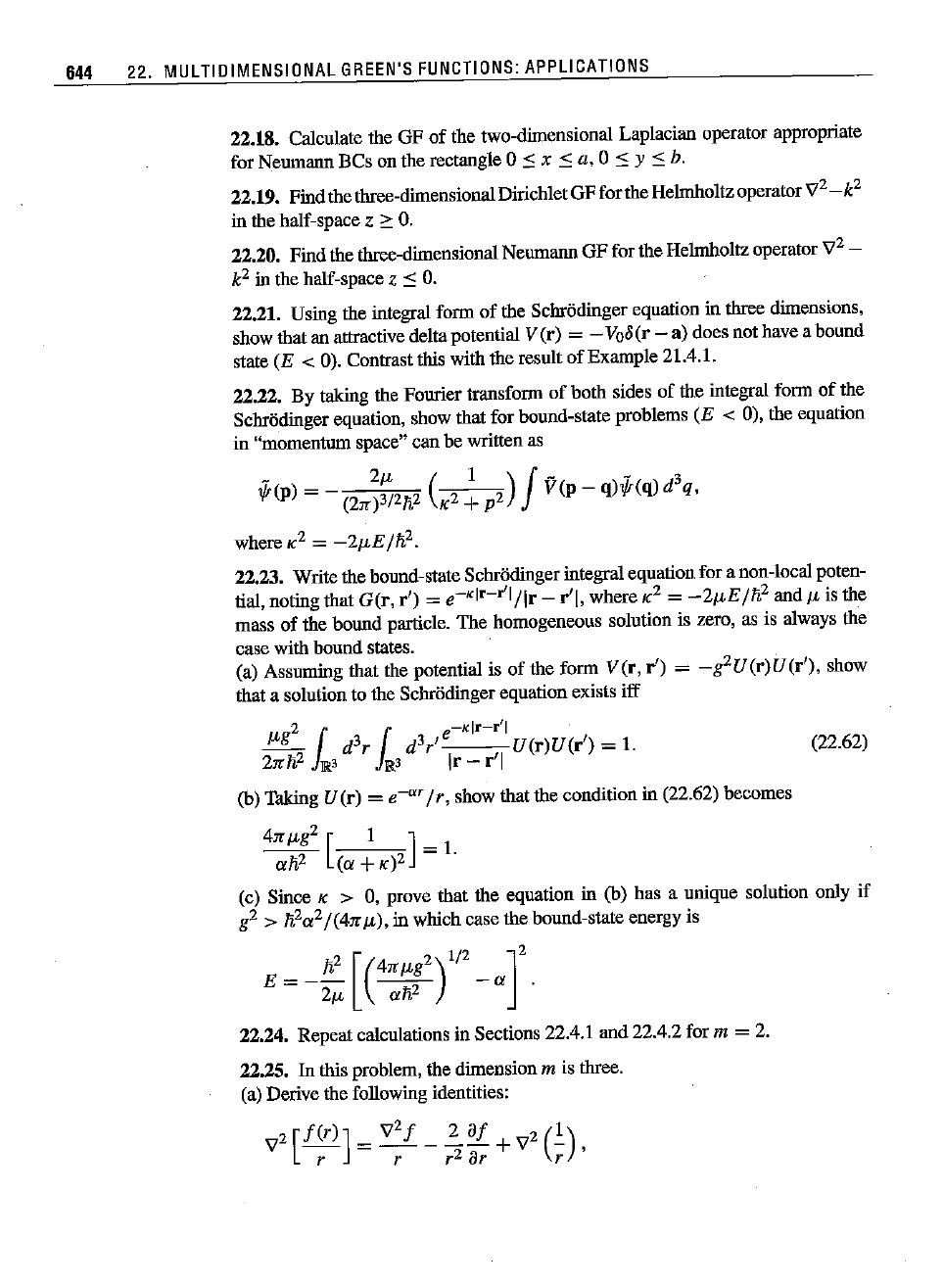
(22.62)
644 22. MULTIDIMENSIONAL
GREEN'S
FUNCTIONS:
APPLICATIONS
22.18. Calculate the GF
of
the two-dimensional Laplacian operator appropriate
for Neumann
Bes
on the rectangle 0 :5 x :5 a, 0 :5 Y :5 b.
22.19. Find the three-dimensionalDirichletGF forthe Helmholtzoperator\72
_k
2
in the half-space z "':
O.
22.20. Find the three-dimensional NeumannGF for theHelmholtz operator \72-
k
2
in the half-space z :5
O.
22.21. Using the integral form of the Schriidinger equation in three dimensions,
show that an attractive delta potential V
(r)
= -
Vo8
(r - a) does not have a bound
state
(E
< 0). Contrast this with the result of Example 21.4.1.
22.22. By taking the Fourier transform
of
both sides of the integral form
of
the
Schriidingerequation, show that for bound-state problems
(E < 0), the equation
in
"momentum
space"
canbe writtenas
'iJ(p) =
(27<~~21i2
C2
~
p2)
J
V(p
- q)'iJ(q)d
3q,
where /(2 =
-2JLElIi
2.
22.23. Write the bound-state Schrodinger integralequation for a non-local poten-
tial, noting that
G(r,
r')
=
e-<lr-r'l
Ilr
- r'[, where /(2 =
-2JLE
lli
2
and
JL
is the
mass of the bound particle. The homogeneous solution is zero, as is always the
case with bound states.
(a) Assnming that the potential is of the form
VCr,
r')
=
-g2U(r)U(r'),
show
that a solution to the Schrodingerequation exists iff
2
M
:
2
{
e, ( d
3r,e-<lr-r'l
U(r)U(r')
= 1.
7<"
JlR3
JlR3
[r -
r'l
(b) Taking U(r) =
e-a'lr,
show that the condition in (22.62) becomes
47<
JLg2
[ I ] _ 1
ali2 (a +
/()2
- .
(c) Since /( > 0, prove that the equation in (b) has a unique solution only if
g2
>
1i2
a2
1(47<
JL),
in which case the bound-state energy is
E =
_1i
2
[(47<JLg
2)
1/2
_
a]2
2JL
ali
2
22.24. Repeat calculations in Sections 22.4.1 and 22.4.2 for m = 2.
22.25.
In
this problem, the dimension m is three.
(a) Derive the following identities:
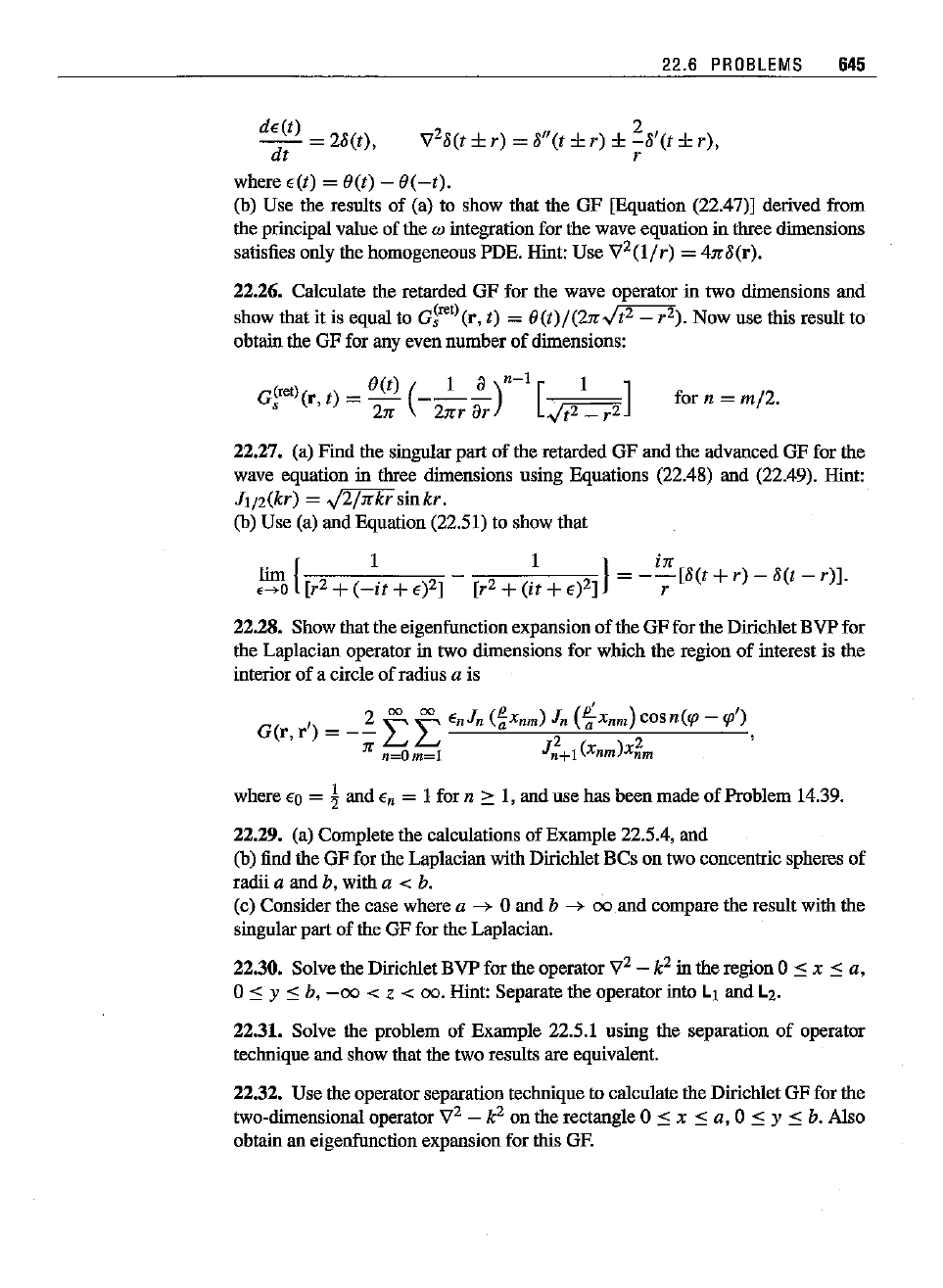
2
V
28(1
±
r)
= 8"(1 ±
r)
±
-8'(1
±
r),
r
for
n = m/2.
22.6
PROBLEMS
645
dE(I) = 28(1),
dl
where E(I) = 0(1) - O(
-t)o
(b) Use the results of (a) to show that the GF [Equation (22.47)] derived from
the principal value of the
ill
integration for the wave equation in three dimensions
satisfies only the homogeneous PDE. Hint: Use V
2(I/r)
=
411"8(r).
22.26. Calcnlate the retarded GF for the wave operator in two dimensions and
show that it is equal to
G~ret)
(r, I) = 0(1)/(211"./1
2
- r
2).
Now use this resnlt to
obtain the GF for any even number
of
dimensions:
G(ret)(r I) _
11(1)
(
__
I_~)n-j
[.
I ]
,
,-
211"
211"r
ar
./12 _ r2
22.27. (a) Find the singniar part
of
the retarded GF and the advanced GF for the
wave equation in three dimensions using Equations (22.48) and (22.49). Hint:
iJ/2(kr)
=
./2/nkrsinkr.
(b) Use (a) and Equation (22.51) to show that
lim
{ I _ I } = _
i1l"
[8(1+
r)
_ 8(1 _
r)]
.
.....
0 [r
2
+
(-il
+E)2] [r
2
+
(it
+E)2] r
22.28. Show that the eigenfunctionexpansion
of
the GF for the DirichletBVP for
the Laplacian operator in two dimensions for which the region
of
interest is the
interior
of acircleof
radius
a is
where
EO
=
~
and En = I for n 2: I, and use has been made of Problem 14.39.
22.29. (a) Complete the calculations of Example 22.5.4, and
(b) find the GF for the Laplacian with Dirichlet BCs on two concentric spheres of
radii a and b, with a < b.
(c) Consider the case where
a
->
0 and b
->
00
and compare the resnlt with the
singular part of the GF for the Laplacian.
22.30. Solve the Dirichlet BVP for the operator V
2
-
k
2
in the region 0
:0:
x
:0:
a,
o
:0:
y
:0:
b,
-00
< z <
00.
Hint: Separate the operator into Lj and L2.
22.31. Solve the problem of Example 22.5.1 using the separation
of
operator
tecimique and show that the two resnlts are equivalent.
22.32. Use the operatorseparation technique to calcnlatethe Dirichlet GF for the
two-dimensional operator V
2
-
k
2
on the rectangle 0
:0:
x
:0:
a, 0
:0:
y
:0:
b. Also
obtain an eigenfunction expansion for this GF.
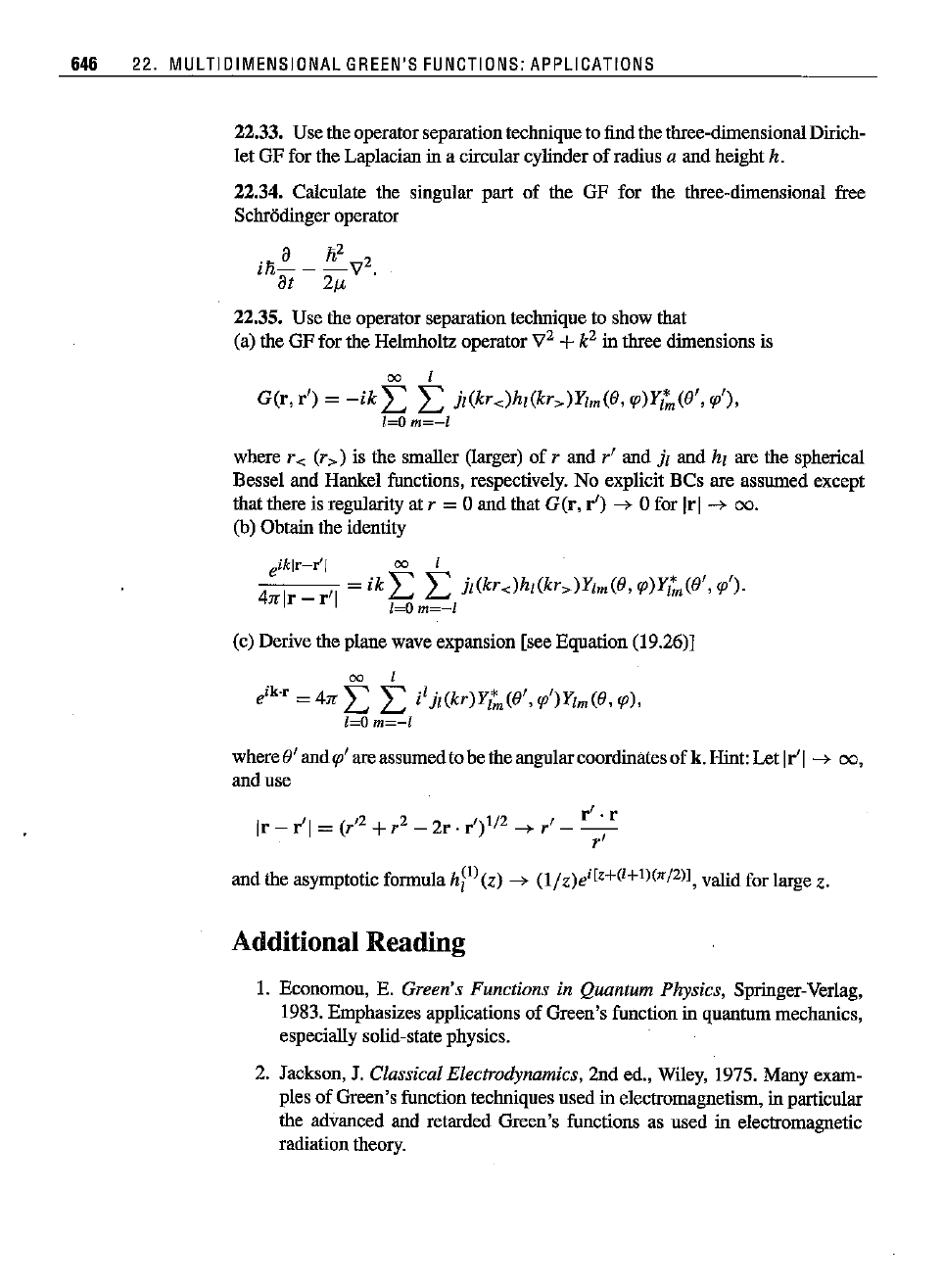
646 22. MULTIDIMENSIONAL
GREEN'S
FUNCTIONS;
APPLICATIONS
22.33. Use the operator separation techniqne to find the three-dimensional Dirich-
let GF for the Laplacian
in a circular cylinder of radius a and height h.
22.34. Calculate the singular part of the GF for the three-dimensional free
Schrodinger operator
a ft2
ift-
-
_';72
at
2fJ-
22.35. Use the operator separation technique to show that
(a) the GF for the Helmholtz operator
';72 +k
2
in three dimensions is
00
I
G(r,
r')
=
-ik
L L
jl(kr
<)hl
(kr»Ylm
«(J,
CP)Y/;n«(J',
cp'),
l=Om=-1
where r-c
(r»
is the smaller (larger) of r and
r'
and
jl
and hi are the spherical
Bessel and Hankel functions, respectively. No explicit BCs are assumed except
that there is regularity at
r = 0 and that
G(r,
r')
--> 0 for [r] -->
00.
(h) Obtain the identity
iklr-r'l
00
I
e =
ik
L L
jl(kr
<)hl(kr»Ylm«(J,
CP)Y/;II«(J',
cp').
4][lr - r'l
I~O
m~-I
(c) Derive the plane wave expansion [see Equation (19.26)]
00
I
e
ik
.
r
= 4][ L L i
l
jl(kr)YI~,«(J',
cp')Ylm«(J,
cp),
[=0
m=-l
where
s'
andcp'areassumed to bethe angular coordinates of k. Hint: Let [r'] -->
00,
and use
r'
r
[r - r'] = (r'2 +r
2
-
2r·
r')1/2 --> r' -
-'-
r'
and the asymptotic formula h?)(z)
--->
(ljz)e
i
[z+(I+I)(
1r
/2)], valid for large z.
Additional Reading
1. Economou, E. Green's Functions in Quantum Physics, Springer-Verlag,
1983. Emphasizes applications of Green's function
in quantum mechanics,
especially solid-state physics.
2. Jackson, J.
Classical Electrodynamics, 2nd ed., Wiley, 1975. Many exam-
ples
of
Green's function techniques used in electromagnetism, in particular
the advanced and retarded Green's functions as used
in electromagnetic
radiation theory.
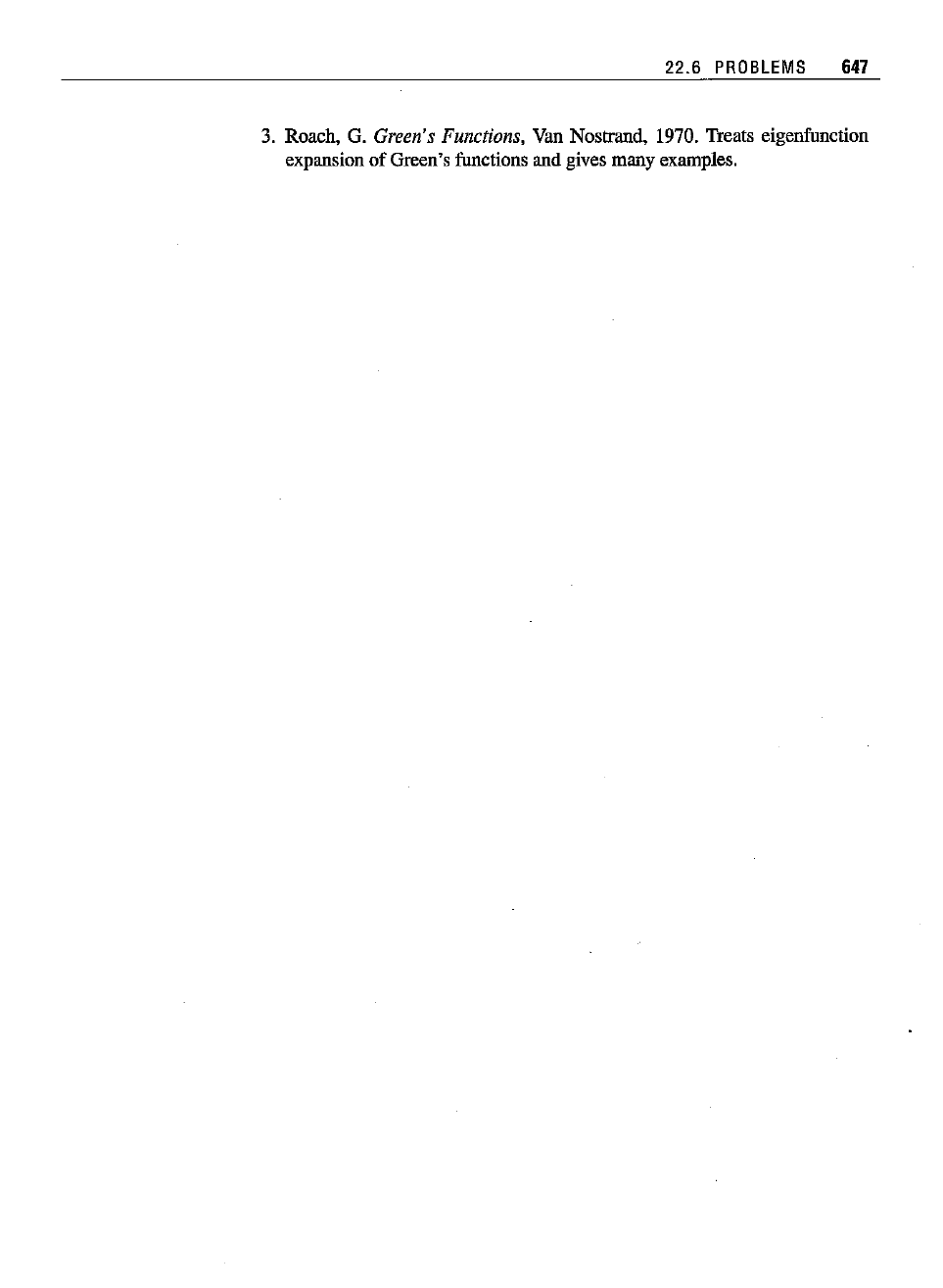
22.6
PROBLEMS
647
3. Roach, G. Green's Functions, Van Nostrand, 1970. Treats eigenfunction
expansion
of
Green's functions and gives many examples.

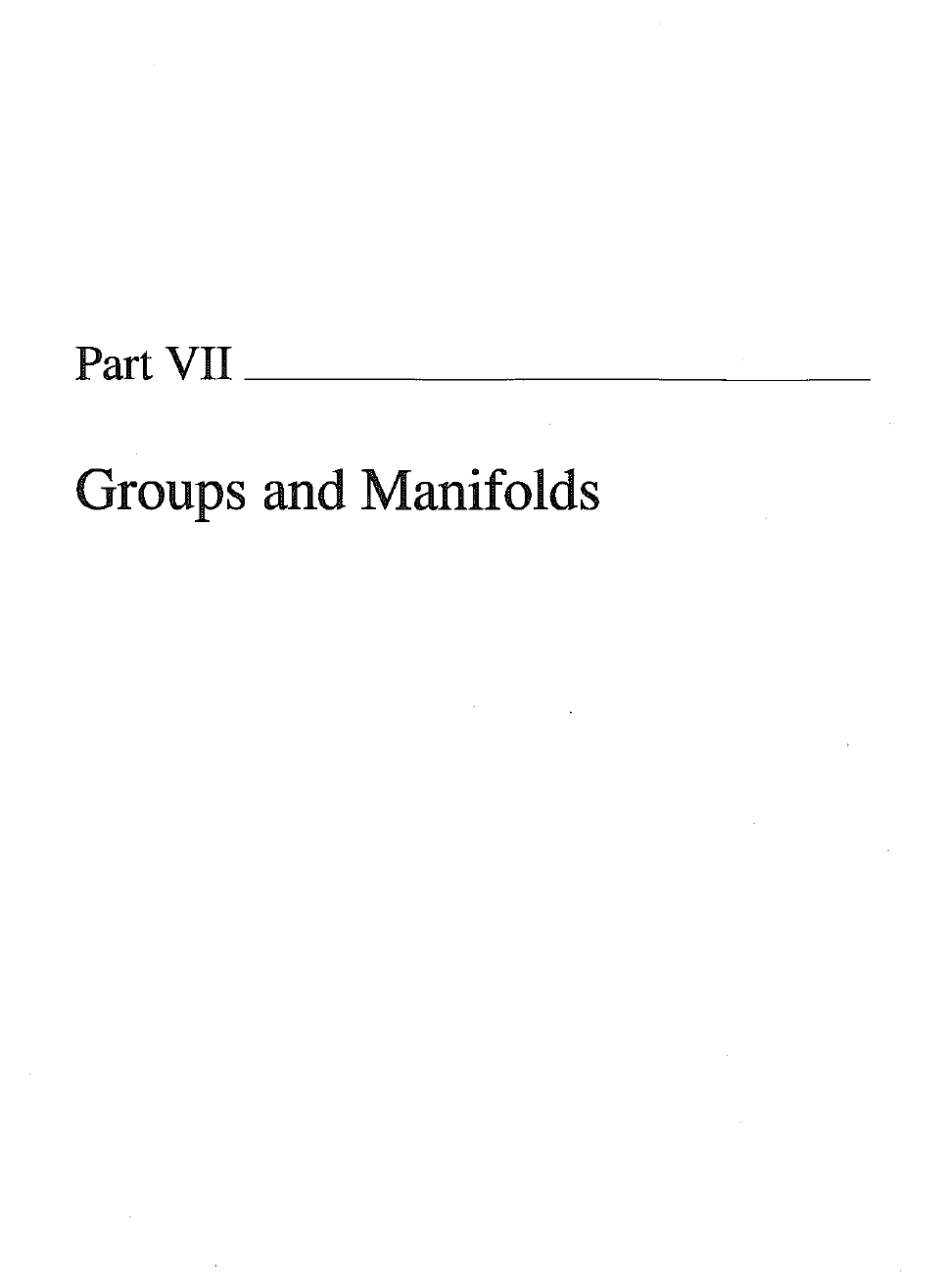
Part VII _
Groups and Manifolds

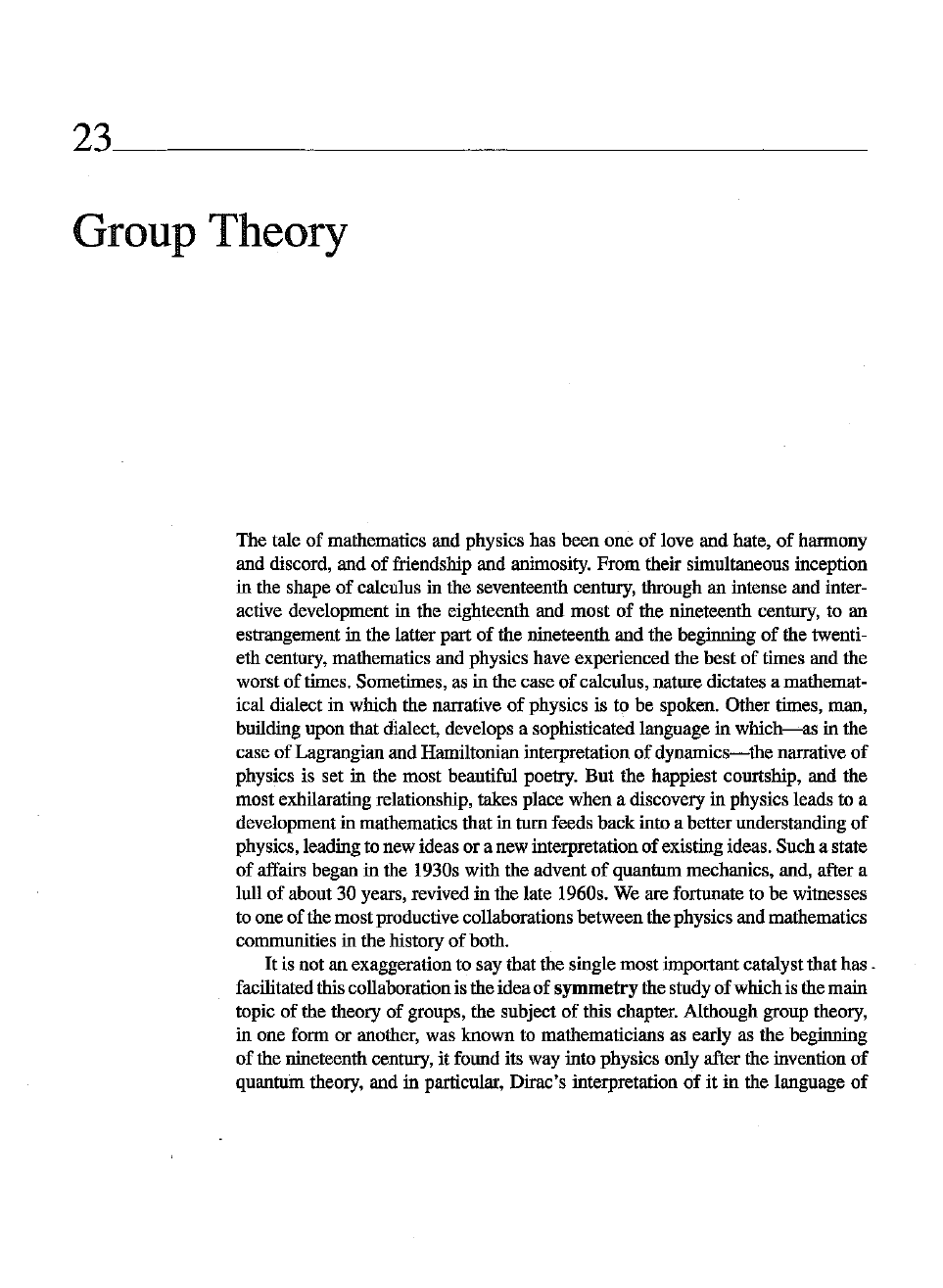
23 _
Group
Theory
The tale of mathematics and physics has been one of love and hate,
of
harmony
and discord, and
of
ftiendship and animosity. From their simnltaneous inception
in the shape
of
calculus in the seventeenth century, through an intense and inter-
active development in the eighteenth and most of the nineteenth century, to an
estrangement in the latter part of the nineteenth and the beginning
of
the twenti-
eth century, mathematics and physics have experienced the best of times and the
worstof times.Sometimes,asin thecase of calculus,
nature
dictates a
mathemat-
ical dialect in which the narrative
of
physics is to be spoken. Other times, man,
building upon that dialect, develops a sophisticated language in which-c-as in the
case of Lagrangian and Hamiltonian interpretation
of
dynamics-the
narrative
of
physics is set in the most beautiful poetty. But the happiest courtship, and the
most exhilarating relationship, takes place when a discovery in physics leads to a
development in mathematics that in
tum
feeds backinto a betterunderstanding
of
physics, leading to new ideas or a new interpretation of existing ideas. Such a state
of affairs began in the 1930s with the advent
of
quantum mechanics, and, after a
lull of about 30 years, revived in the late 1960s. We are fortunate to be wituesses
to one of the most productive collaborations between the physics and mathematics
communities in the history of both.
I!
is not an exaggeration to say that the single most importantcatalystthat has -
facilitated this collaborationisthe ideaof
symmetry
the study of whichis the main
topic of the theory of groups, the subject of this chapter. Although group theory,
in one form or another, was known to mathematicians as early as the beginning
of the nineteenth century, it found its way into physics ouly after the invention
of
quantum theory, and in particular, Dirac's interpretation
of
it in the language
of
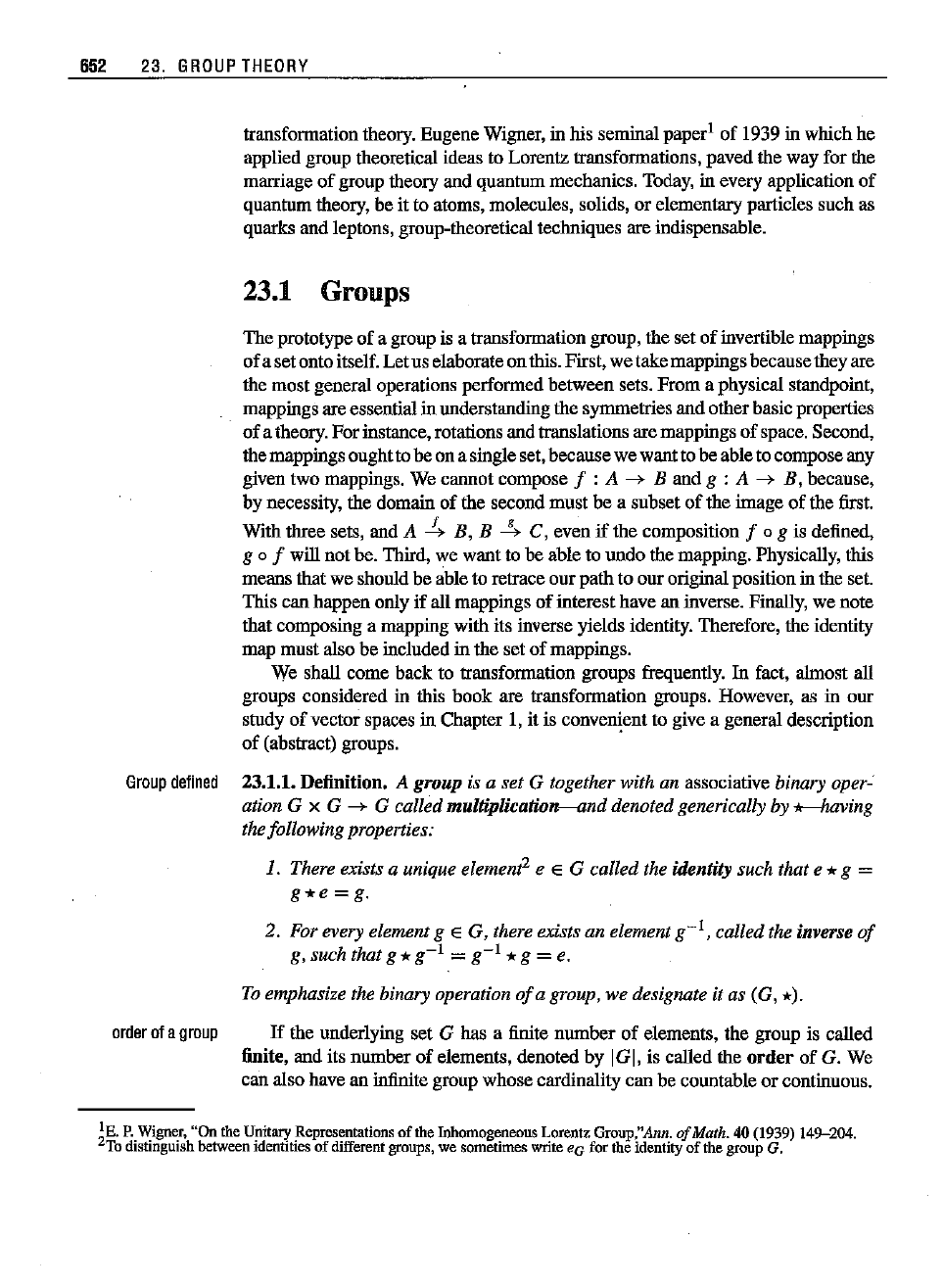
652
23.
GROUP
THEORY
transformation theory. Eugene Wigner, in his seminal paper! of 1939 in which he
applied group theoretical ideas to Lorentz transformations, paved the way for the
marriage
of
group theory and quantum mechanics. Today, in every application
of
quantum theory, be it to atoms, molecules, solids, or elementary particles such as
quarks and leptons, group-theoretical techuiques are indispensable.
23.1 Groups
The prototype of a group is a transformation group, the set of invertible mappings
of a set onto itself. Let us elaborateon this. First,we take mappingsbecausethey are
the most general operations performed between sets. From a physical standpoint,
mappings are essential in understanding the symmetries and otherbasic properties
of
a theory. For instance, rotations and translations are mappings of space. Second,
the mappings oughtto be on a single set, becausewe want tobe able to composeany
given two mappings. We cannot compose
f : A
--->
B and g : A
--->
B, because,
by necessity, the domain of the second must be a subset
of
the image of the first.
With three sets, and
A
J..
B, B
.!,
C, even
if
the composition
fog
is defined,
g 0 f will not be. Third, we want to be able to undo the mapping. Physically, this
means that we should be able to retrace
our
pathto our original positionin the set.
This can happen only if all mappings
of
interesthave an inverse. Finally, we note
that composing a mapping with its inverse yields identity. Therefore, the identity
map must also be included in the set of mappings.
We shall come back to transformation groups frequently.
In fact, almost all
groups considered in this book are transformation groups. However, as in our
study
of
vector spaces in Chapter I, it is convenient to give a general description
of (abstract) groups. .
Group
defined
23.1.1. Definition. A group is a set G together with an associative binary oper-
ation
G x G
--->
G called multiplication---<lnddenoted generically by *-""aving
thefollowing properties:
1. There exists a unique
eiemenr e E G called the Ulentiry such that e *g =
g*e=g.
2. For every element g E G, there exists an element
g-l,
called the inverse
of
g, such that g *
g-I
=
g-I
*g =e.
Toemphasize the binary operation
ofa
group, we designate it as (G, *).
order
ofa
group
If
the underlying set G has a finite number of elements, the group is called
finite, and its number of elements, denoted by
1GI,is called the
order
of G. We
can also have an infinite group whosecardinality can be countable or continuous.
~E.
P. Wigner, "On the UnitaTf Representations
of
the Inhomogeneous Lorentz Group,"Ann. afMath. 40 (1939) 149-204.
To distinguish between
identities
of
different groups, we sometimes write
ec
for the identity
of
the group G.
